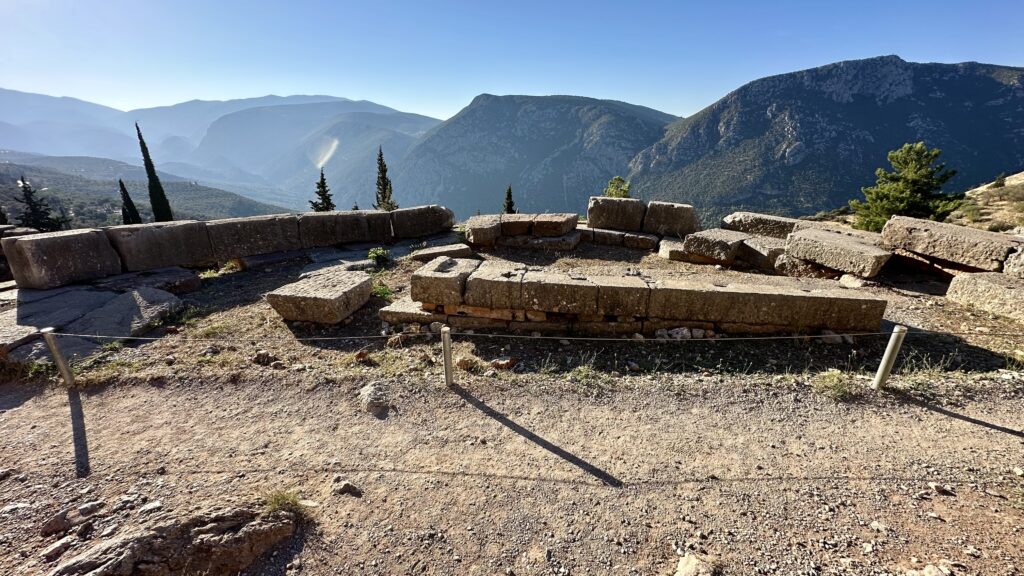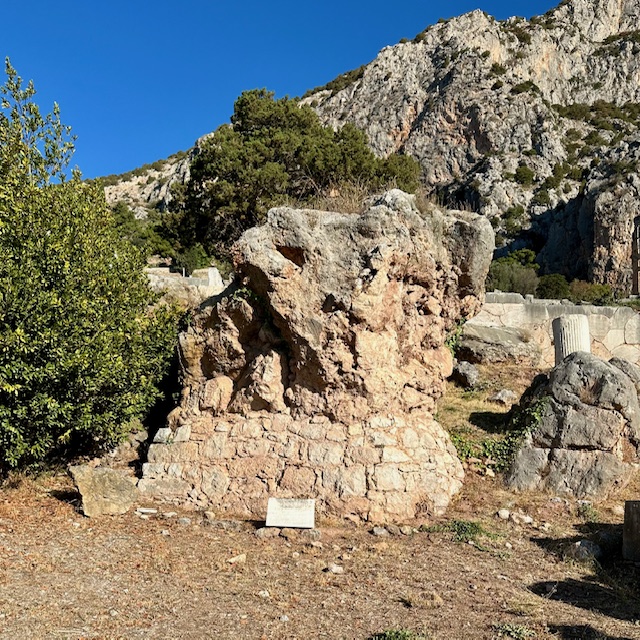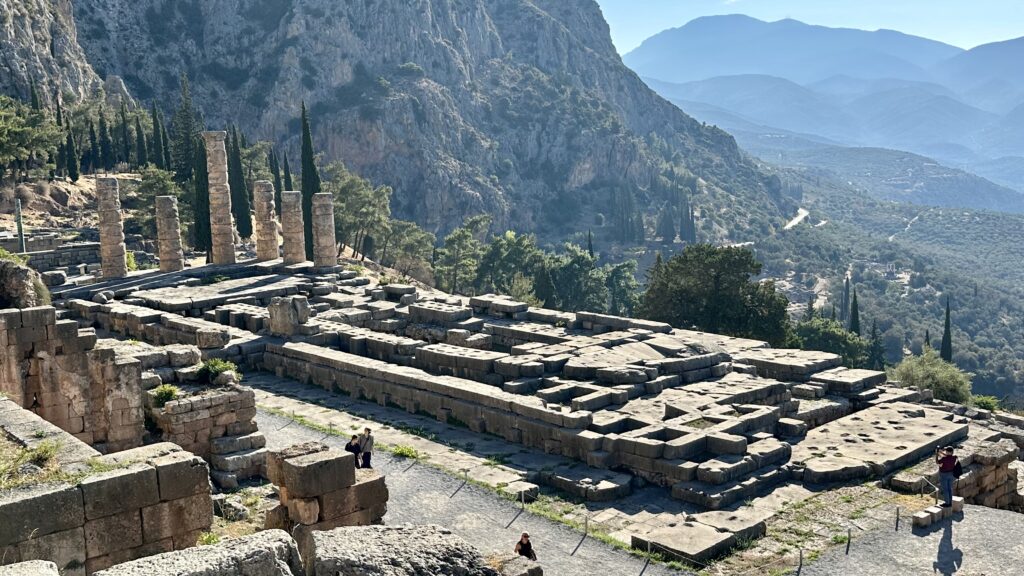Overnight in Nidimos Hotel
The ancient town of Delphi, is about 184 km north of Athens and it took us 2 hours to get there. The roads up to Delphi are quite hilly but well maintained and the scenery along the way was lovely. Delphi is a major archaeological site with well-preserved ruins in a magnificent mountain setting. It was designated a UNESCO World Heritage Site in 1987.
Delphi was considered by the ancient Greeks to be the centre of the world. According to ancient myth, Zeus released two eagles, one from the east, the other from the west, and caused them to fly toward the center. They met at the future site of Delphi, and the spot was marked by a stone called the omphalos (navel), which was later housed in the Temple of Apollo. The archaeological site of Delphi includes two sanctuaries, dedicated to Apollo and Athena, and other buildings, mostly intended for sports. Visitors arriving from Athens first encounter the sanctuary of Athena Pronaia – that is, Athena who is before the temple of Apollo.
We reached Delphi in the afternoon. After checking into out hotel and having lunch, we decided to explore the small town. There are only 2 narrow roads one of which leads to the archaeological site and museum and was within 15 min walking distance from our hotel. Some information about the Archaeological site :
- €12 includes visits to the Museum and Archaeological Site (Temple of Apollo), both of which has to be done on the same day. The Museum closes at 5pm and the Archaeological Site closes at 7pm.
- It takes about 2-3 hours to see the entire Archaeological Site even if you are not interested in history. Lots of uphill walking involved.
- Plan on spending at least an hour in the museum even if you are not interested in history
- The sanctuary of Athena Pronaia is free to visit whenever you want. This is the first ruin you will encounter when driving into Delphi from Athens. It is situated downhill on the opposite side of the road from Museum and Archaeological Site (Temple of Apollo).
The Tholos in Athena Pronaia – Since it was near museum closing time when we arrived, we decided to visit sanctuary of Athena Pronaia first which is free to visit and open 24/7. Within this 4th century BC Sanctuary stands the Tholos (meaning a circular roof or dome) with the remains of 20 Doric columns on the outside and 10 Corinthian columns on the inside. Although exact function is unknown, it is considered a masterpiece of classical architecture.


Ancient Gymnasium – The Ancient Gymnasium of Delphi is a complex of buildings that was built in the 4th century BC. It was a training facility for athletes competing in the Delphic Games, and was also used for cultural events. The gymnasium is on the southern side of the Delphi Archaelogical site close to the Sanctuary of Athena Pronaia. You can get a great view of the gymnasium from the road to as you drive to Delphi from Athens.



We arrived early at the archaeological/museum site next day morning to beat the heat and crowd. End of September was still hot and the bus tour crowd was beginning to come in. Self guided tours can be downloaded on the phone at the site which will help in locating the places of interest as you walk among the ruins.
Sacred Way – This path is the main route leading from the entrance uphill 200m to the Temple of Apollo. All along the sacred way on both sides were placed large and small monuments set up by individuals, cities, and kingdoms. Majority of them commemorated famous victories either on battlefield or at the Pythian Games held to honor the Greek God Apollo. Most of the monuments have been destroyed or have disappeared but some of their bases have survived.



The Navel of the earth – The sacred omphalos of Delphi, believed to have fallen from heaven was shaped like a conical stone. It was also identified with the stone thrown by Zeus from the heaven to discover the center of the world. Legend has it that Zeus simultaneously released two eagles, one from the east and the other from the west. At the point where the two god-sent birds met, Zeus threw down a stone that landed in Delphi. Nearby stood the impressive sanctuary of Apollo, home to the most important oracle of antiquity. According to tradition, the oracle originally belonged to Gaia (Mother Earth), who lived there with her son Python. But the god Apollo transformed into a dolphin reached the port of Delphi, Kirra, killed Python and founded his own sanctuary, the Temple of Apollo. From then on, pilgrims from far and wide flocked to the oracle, seeking the guidance of Apollo’s priestess. As a tribute to Apollo, the Pythian Games were held there every four years and were the precursor of the Olympic Games which were held in Olympia.

The original omphalos of Delphi is displayed in the Archaelogical Museum of Delphi.


The Treasury of the Athenians was built in the early 5th century BC and in the form of a Doric temple and it dominated the Sacred Way. The building contained trophies from important Athenian victories and other votive objects dedicated to the sanctuary. The Treasury of the Athenians was the only Delphic monument that still preserved much of its ancient fabric in the early twentieth century, and so was re-erected by the French School in 1906 with funds granted by the mayor of Athens.


Sibyl Rock – Adjacent to the Treasury of the Athenians is a large, protruding boulder. This is Sibyl Rock. Legend suggests the earliest high priestess of Delphi stood here to proclaim her prophecies. Successive female prophets were also given the title of Sibyl until the role evolved into the Oracle of Delphi.

Stoa of the Athenians – is an ancient portico built against the polygonal wall supporting the terrace of the temple of Apollo. The southern side of the polygonal wall of the platform forms the north wall of the stoa. The stones that make up the wall are cut into unusual polygonal shapes and hence the name. The stoa was constructed in Delphi after the naval victory over the Persians at Sestus near the Hellespont in 478 BC. It was dedicated to Apollo, and the Athenians that perished in the Persian War.


Temple of Apollo – The temple of Apollo, is the the most important building in the sanctuary of Apollo at Delphi. This is where the statues and other offerings to the god were kept and rituals took place. Also, here was where the archive which contained the lists of victors of the Pythian games and destroyed in 373 BC were kept.




Ancient Theater – A flight of steps leads up to the well preserved theater. Dating from the 4th century BC, the theater was constructed using the limestone of Mount Parnassus. The theater could accommodate 5,000 spectators in the 35 rows of stone benches. Its location at the top provided audiences with a great view of the entire sanctuary and the valley below.


The Stadium – At the highest point of the Archaelogical site lies the Stadium which hosted the Pythian Games. Its tiered stone seating could accommodate 500 spectators.




Archaeological Museum of Delphi – This is one of the most popular and visited museum in Greece. Founded in 1903, it has displays organized in 14 rooms on 2 levels and houses discoveries made at various sanctuaries in Greece dating from Mycenean period to early Byzantine era. We spent a little more than an hour at this museum.


Some of the other displays in the museum include: Bronze statue of Charioteer of Delphi – This was one of the few bronze statues that was preserved , thanks to it being buried due to the earthquake of 373 BC. Most of the other bronze objects disappeared or were destroyed. Charioteers who participated in the panhellenic games were youth of noble origin, aristocrats like the owners of chariots and horses.
Statue of Antinuous – was a young Greek of extraordinary beauty who became the beloved companion or lover of the Roman emperor Hadrian who died young. Stricken by the death of Antinous, Hadrian, gave orders that statues of the beautiful young man, whom he had loved so passionately, should be erected in all sanctuaries and cities of his vast empire.
Dancers of Delphi – were discovered in the same location as the remains of the frontage of the archaic temple of Apollo and probably belonged to the period 335-325 BC.



Town of Delphi – The small but modern town of Delphi is within walking distance of the archaeological site and has may hotels, guesthouses, restaurants, and shops. You can walk the entire town in less than an hour. We had a great view of the city from our hotel.



Is Delphi worth visiting – Absolutely… All the sights on this page will take 5-7 hours at the most depending on how interested you are in Greek/World history. You could even visit this place on a day trip from Athens or Meteora.